AA Research Clusters are year-long special projects, activities and events that bring together diverse groups of AA staff, students and outside partners – audiences, specialists, researchers – to realise a body of focused research. Originally conceived in 2005, Research Clusters are mechanisms for triggering new territories and modes of research. The clusters are intended to promote and cultivate the culture of applied research in the school.
Each year the AA Research Cluster Group, in consultation with existing cluster curators, takes applications from across the school for a new cycle of research areas; there are usually four clusters operating at any one time. In addition to developing expertise and specific projects, Research Clusters seek to challenge existing forms of research and presentation – exploring alternative ways in which work can be produced. These might include events, symposia, conferences, workshops, performances, publications off- or on-site exhibitions, fabrications and interdisciplinary collaborative research and competitions.
Paradise Lost
Cluster Curator: Mark Campbell
This research cluster has been exploring the notion of architectural obsolescence with a study of the contemporary United States. If during the twentieth century the US was the world’s greatest economic, scientific and cultural force, it now faces an unplanned obsolescence as changing patterns of consumption and demand result in an architectural redundancy in which architecture often exists solely as a form of by-product or residue.
In recognition of this dynamic, the cluster has begun to sift through these residues in the hope of determining the words and images that truly speak of paradises lost. As Walter Benjamin reminds us, history is not only comprised of such images but is also itself an image. Following this lead, we have examined the work of a number of prominent photographers – Walker Evans, Robert Frank, William Klein, Garry Winogrand, William Eggleston, Jacob Holdt, Stephen Shore, Joel Sternfeld and Alec Soth – who have all sought to consider the United States in imagistic terms. In sifting through these photographs it is striking how certain tropes or visual tics recur. We have assembled these images of guns, household objects, road trips, cars, bodies, acts of devotions and TVs into atlases that illustrate how we are concerned less with what these images describe than we are with attempting to understand what they are ‘about’.





























































